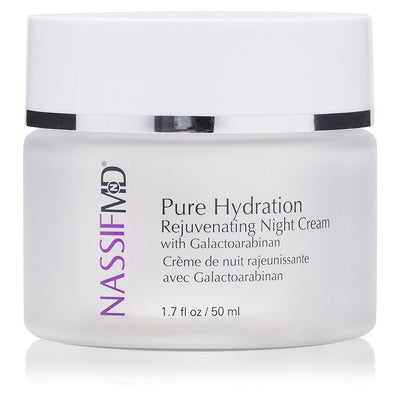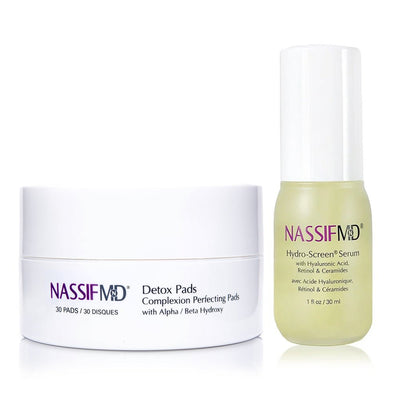How to Prevent and Treat Sun-Damaged Skin
You may have grown up seeking more sun and that perfect summer tan. However, those days are over. It’s more evident than ever that the sun ages you; it contributes to wrinkles, crepey skin, dark spots, and more. If you want to maintain your youthful appearance, protecting your skin from the sun is crucial.
Whether you want to focus on sun protection or rejuvenate sun-damaged skin (or both), today’s article is for you. Keep reading to learn how to leverage your skincare routine to prevent and treat sun damage:
- The simple skincare routine to prevent sun-damaged skin
- How to reverse sun damage with a synergy of active ingredients
- When to see a dermatologist
- Cutting-edge facial surgeon formulas with demonstrated and lasting results
Skincare Routine for Preventing Sun-Damaged Skin
The best skincare routine for preventing sun damage is the routine you will follow to stay out of the sun or protect your skin while in it. It’s never too late to start preventing further damage. Prevention truly is the best medicine for your skin.
Let’s look at some of the best ways to protect yourself from the aging effects of the sun.
Sun Lotion
The best sun tan lotion or sun lotion is sunscreen. A daily product that protects the skin from ultraviolet (UV) radiation is a must-have if you spend time outdoors, even on cloudy days or in the winter.
A lightweight sunscreen, such as NassifMD® Defend & Soothe, is an easy addition to your skincare routine steps and wears easily under makeup.
Sunscreen is often the primary skincare tool used to prevent sun damage and the associated signs of aging; however, it’s also supportive to consider antioxidants as your first line of defense against UV radiation, pollution, and toxins your skin encounters. Antioxidants, including vitamin C, concentrate in the outer layers of the skin to protect against free radical damage.
Protective Clothing
Sunscreen is most effective when an optimal amount is applied and reapplied every 2 hours. When you spend a lot of time in the sun, choosing to wear protective clothing that covers more of your body may be easier. A long sleeve sun shirt plus a wide-brimmed hat provides excellent protection.
Limiting Sun Exposure
Limiting sun exposure is the most effective way to prevent sun damage on the face. Limit skin exposure to peak sunlight between 10am and 2pm. Choose more outdoor time early in the morning and evening when the sun’s rays aren’t as intense.
How to Reverse Sun-Damaged Skin
While preventing sun damage is ideal, what do you do if you are already experiencing sun damage as accelerated signs of aging, including wrinkles, crepey skin, loose skin, and pigmentation changes?
Let’s look at active skincare ingredients proven to nourish, hydrate, and revitalize sun-damaged skin.
Retinol
Retinol is an active form of vitamin A, involved in the constant regeneration of skin cells and building the skin’s structure. Because of these functions, topical retinol cream is the most researched anti-wrinkle and anti-aging treatment.
UV radiation from the sun damages the skin (photodamage), it’s common to experience darkening and areas of uneven skin tone. Retinol treats pigmentation changes and other signs of aging across skin types and skin color. In addition, retinol supports the remodeling of photodamaged skin.
Azelaic Acid
Azelaic acid is a natural dicarboxylic acid found in wheat, commonly used as a dermatologic ingredient in acne and rosacea treatments.
Unlike the hydroxy acids, BHA and AHA for skin, this acid isn’t an exfoliator. Instead, azelaic acid decreases melanin production in skin cells. Since increased melanin contributes to hyperpigmentation and age spots, using azelaic acid evens skin tone. Research suggests a new application for azelaic acid as a depigmentation and anti-aging treatment.
Niacinamide
Niacinamide is a form of niacin (vitamin B3) involved in cellular energy production. It acts as an antioxidant, stabilizes the skin barrier, and improves the appearance of fine lines. In addition, niacinamide in skincare products proves an effective anti-aging treatment, primarily because it affects melanin synthesis and acts as a depigmentation agent to even skin tone caused by sun damage.
Hyaluronic Acid
Hyaluronic acid is a star ingredient in hydrating skin products and for good reasons. Hyaluronic acid pulls moisture into the skin for plumper, more hydrated, radiant skin. In addition to skin hydration, hyaluronic acid benefits include:
- Improving the appearance of fine lines and wrinkles
- Protecting the skin barrier
- Skin rejuvenation and reduced signs of skin aging
- Improving skin elasticity and firmness
For more on how to hydrate skin, read How to Hydrate Your Skin for a Youthful Appearance.
Vitamin C
Vitamin C is a critical antioxidant for skin health. It’s also known for increasing collagen production in the skin and, therefore supporting skin structure. It’s also a lightening and brightening agent that evens skin tone. You’ll find vitamin C as an effective ingredient in face serums.
A 2023 study asserts, “…vitamin C is effective in treating uneven, wrinkled skin and has depigmenting properties.” It’s often used for melasma (dark pigmentation areas) and skin damage from sun exposure.
When to See a Dermatologist
Pay attention to changes in your skin, including changes in pigmentation, sun damage, and skin aging, and consult a dermatologist for regular skin checks. In addition, your dermatologist may have other treatment strategies for sun skin damage that may be helpful in addition to the ideas in this article.
NassifMD® Radiance Brightening Booster and Simply Hydration
Not all skincare is created equal. Dr. Nassif knows skin from the inside out and formulates products to prevent and address sun damage using transparent science. When it comes to sun damage and preventing it, you’ll want NassifMD® Radiance Brightening Booster and NassifMD® Defend & Soothe as part of your daily skincare routine.
NassifMD® Radiance Brightening Booster – Vitamin C Serum provides antioxidant protection against sun damage while also addressing previous damage. It brightens the skin, reverses signs of aging, and reduces dark spots for more even pigmentation.
In addition to 10% vitamin C, this serum contains squalene, a natural emollient from plant sugar and olives, to decrease inflammation, support skin flexibility, and prevent moisture loss. You’ll find it in a base of nourishing meadowfoam seed oil and anti-inflammatory fatty acids to protect the skin from UV damage.
NassifMD® Simply Hydration is Dr. Nassif’s premier hydrating sunscreen that protects the face from UVA and UVB rays. It’s more than just a sunscreen; it also contains hyaluronic acid, making it ideal for daily use. It also contains vitamin E (tocopherol), apple extract, knotweed extract for antioxidant and anti-inflammatory benefits. It’s a true multi-purpose formula to hydrate, nourish, and protect the skin. Best of all, it’s lightweight, oil-free, with a smooth cosmetic-grade application.
When thinking about skincare routines, don’t forget prevention. Preventing sun damage now will preserve and strengthen your skin for decades. And aging skin or skin with sun damage, there are many research-backed ingredients to revitalize and rejuvenate the skin. These ingredients are the backbone of NassifMD® skincare.
References
- Ho, C. Y., & Dreesen, O. (2021). Faces of cellular senescence in skin aging.Mechanisms of ageing and development, 198, 111525.
- Bennett, S. L., & Khachemoune, A. (2022). Dispelling myths about sunscreen.The Journal of dermatological treatment, 33(2), 666–670.
- Zasada, M., & Budzisz, E. (2019). Retinoids: active molecules influencing skin structure formation in cosmetic and dermatological treatments.Postepy dermatologii i alergologii, 36(4), 392–397.
- Sadick, N., Edison, B. L., John, G., Bohnert, K. L., & Green, B. (2019). An Advanced, Physician-Strength Retinol Peel Improves Signs of Aging and Acne Across a Range of Skin Types Including Melasma and Skin of Color.Journal of drugs in dermatology : JDD, 18(9), 918–923.
- Mellody, K. T., Bradley, E. J., Mambwe, B., Cotterell, L. F., Kiss, O., Halai, P., Loftus, Z., Bell, M., Griffiths, T. W., Griffiths, C. E. M., & Watson, R. E. B. (2022). Multifaceted amelioration of cutaneous photoageing by (0.3%) retinol.International journal of cosmetic science, 44(6), 625–635.
- Searle, T., Ali, F. R., & Al-Niaimi, F. (2022). The versatility of azelaic acid in dermatology.The Journal of dermatological treatment, 33(2), 722–732.
- Zaid, A. N., & Al Ramahi, R. (2019). Depigmentation and Anti-aging Treatment by Natural Molecules.Current pharmaceutical design, 25(20), 2292–2312.
- Gehring W. (2004). Nicotinic acid/niacinamide and the skin.Journal of cosmetic dermatology, 3(2), 88–93.
- Zaid, A. N., & Al Ramahi, R. (2019). Depigmentation and Anti-aging Treatment by Natural Molecules.Current pharmaceutical design, 25(20), 2292–2312.
- Bukhari, S. N. A., Roswandi, N. L., Waqas, M., Habib, H., Hussain, F., Khan, S., Sohail, M., Ramli, N. A., Thu, H. E., & Hussain, Z. (2018). Hyaluronic acid, a promising skin rejuvenating biomedicine: A review of recent updates and pre-clinical and clinical investigations on cosmetic and nutricosmetic effects.International journal of biological macromolecules, 120(Pt B), 1682–1695.
- Bravo, B., Correia, P., Gonçalves Junior, J. E., Sant'Anna, B., & Kerob, D. (2022). Benefits of topical hyaluronic acid for skin quality and signs of skin aging: From literature review to clinical evidence.Dermatologic therapy, 35(12), e15903.
- Correia, G., & Magina, S. (2023). Efficacy of topical vitamin C in melasma and photoaging: A systematic review.Journal of cosmetic dermatology, 22(7), 1938–1945.






















